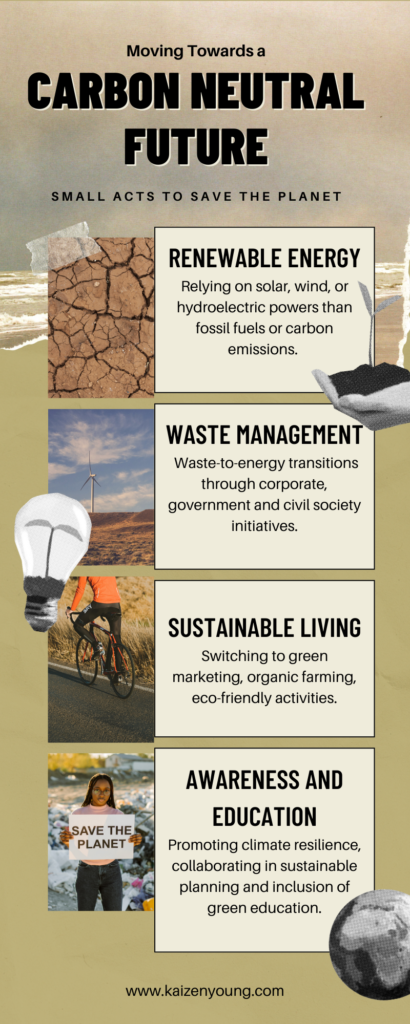Sustainable Energy Transitions: Strategies for a Carbon-Neutral Future
Introduction
In November 2021, at the 26th session of the United Nations Framework Convention on Climate
Change (COP 26), India promised to cut down the carbon emissions to net-zero by 2070.
Does that mean, India will completely bring the emissions to zero?
No, rather it refers to a state of carbon neutrality. It simply means to curate a level of emissions where the amount of greenhouse gasses (GHGs) emitted is balanced with the GHGs that are eliminated from the atmosphere. For this various means are to be adopted. The government has extensive plans in this regard, with several initiatives and strategies being adopted to restructure existing industries and instate new ones. Automatically, the business sector is the most affected in this transition.
Does that mean, India will completely bring the emissions to zero?
No, rather it refers to a state of carbon neutrality. It simply means to curate a level of emissions where the amount of greenhouse gasses (GHGs) emitted is balanced with the GHGs that are eliminated from the atmosphere. For this various means are to be adopted. The government has extensive plans in this regard, with several initiatives and strategies being adopted to restructure existing industries and instate new ones. Automatically, the business sector is the most affected in this transition.
How to Go Green?
Embracing sustainability can no longer be a farther decision. It is here and now. Before we delve
into ways to indulge sustainable energy into your business, go through these general best
practises to know where the changes should begin from:

Green Business Model
A successful startup always foresees on par with its competitors the trends of its market. They
often employ models that are experimental and lead the way to fashion the future business
models. That is why there are several companies treading the AI path, adapting themselves to the
very near future.
Sustainability connects the future to the present and keeps both safe, the present from guilt of exploitation and future from exhaustion of resources. Some businesses have already chosen this path to enhance their productivity and brand identity as well as the overall welfare of the market and the society.
Sustainability connects the future to the present and keeps both safe, the present from guilt of exploitation and future from exhaustion of resources. Some businesses have already chosen this path to enhance their productivity and brand identity as well as the overall welfare of the market and the society.
- Unilever’s Sustainable Living Plan, sources organic agricultural goods for its food brands, along with focusing on waste reduction in the supply chain.
- IKEA has laid down goals to become climate positive and a recycling venture by 2030. It has also taken staunch investment policies to source renewable energy sources for its production.
- Reliance Industries is actively involved to become a net-zero company by 2035. Exploring green hydrogen production, they are undertaking measures to adopt carbon capture and utilization(CCU) technologies.
- Tata Motors is shifting its focal limit to electric and hybrid vehicles which will have positive impacts in the automobile industry of India.
- Another big group, Nestle India claims to reduce net emissions to zero by 2050, and is taking active steps to switch to energy-efficient technologies and relying on sustainable raw materials.
- Fabindia, which uses environmentally friendly stores with energy-saving lighting, selling products manufactured with materials like natural dyes and organic cotton, sourcing products from local artisans.
- Digital Green is an NGO that merges technology and social institutions to work towards improving the farming, health and nutrition sector through innovation, especially in the rural areas.
- Big Basket, a chain store, adopts sustainable practices such as biodegradable packing materials and electric vehicles to drop delivery goods, also while sourcing supply directly from the farmers to cut down carbon emissions.
- Waste Ventures India works to reduce waste dumping to turn the rubbish into nutrient-rich organic compost, collaborating with local municipalities and waste pickers.
- HelpUsGreen collects waste flowers to upcycle them into certified organic products like luxury incense and bathing bars.

The Road Ahead
Not every business can be based on sustainability, but can surely incorporate sustainable
principles in their business practices into their daily processes. Many benefits that are available
can be encashed by the startups like green financing, to find their feet. Some efforts that can be
put towards this front are as follows:
- Set achievable sustainable goals incorporating targets and means to adopt
- Practice energy efficiency from the grassroots level efforts such as using LED lighting, solar appliances, smart thermostats, commercial e-vehicles etc.
- Invest in carbon offset projects including reforestation, water and waste management etc.
- Relying on carbon credits to sustainably manage land conservation and financial needs.
- Identify suppliers who prioritize sustainability, who can contribute to reducing carbon emissions.
- Using sustainable materials, investing in recyclable raw materials and minimizing waste output all through the product designing process.
- Adhering to green building design principles to reduce energy consumption.
- Measuring and feedback of carbon emission at each step to keep track of the metrics and to improve further.
- Collaborating with sustainability-centric brands while promoting your own brand and for internal processes.
- Engaging with international climate finance mechanisms to fund projects that can contribute to net-zero production outputs





